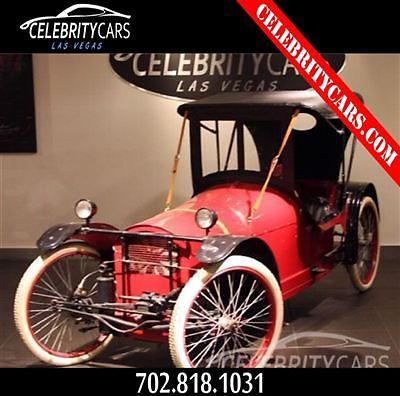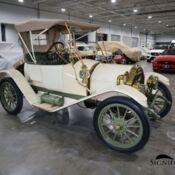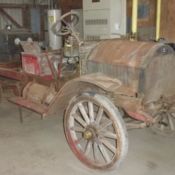2 Seater 1912 Pioneer Cyclecar Restored and very Rare V-Twin Belt Drive 2 dr Con
1912 Pioneer Cyclecar
Vehicle Overview| 1912 Pioneer Cyclecar Restored and very Rare V-Twin Belt Drive |
1912 Pioneer Cyclecar Restored
This is the only one in the world based on the original Stout design that came out first in 1912. Imps were not produced until 1913. There are two Imps possibly three left in existence.
This Cycle car has all the parts and is in need of the Belts for the belt drive to operate the vehicle.
Here is a brief history on cycle cars:
Cyclecars were small, generally inexpensive cars manufactured mainly between 1910 and the late 1920s.
Cyclecars were propelled by single cylinder, V-twin or more rarely four cylinder engines, often air cooled. Sometimes these had been originally used in motorcycles and other components from this source such as gearboxes were also employed. Cyclecars were half way between motorcycles and cars and were fitted with lightweight bodies, sometimes in a tandem two-seater configuration and could be primitive with minimal comfort and weather protection. They used various layouts and means of transmitting the engine power to the wheels, such as belt drive or chain drive often to one rear wheel only to avoid having to provide a differential.
The rise of cyclecars was a direct result of reduced taxation both for registration and annual licenses of lightweight small engined cars. In France, for example, a car was classed for reduced rates if it weighed less than 350 kg (772 lb).
On 14 December 1912, at a meeting of the Federation Internationale des Clubs Moto Cycliste, it was formally decided that there should be an international classification of cyclecars to be accepted by the United Kingdom, Canada, United States, France, Holland, Belgium, Italy, Austria and Germany. It was also decided to establish two classes of cyclecars, as follows;
(i) Large class
Maximum weight 350 kg (772 lb)
Maximum engine capacity 1100 cc
Minimum tyre section 60 mm (2.4 in).
(ii) Small class
Minimum weight 150 kg (331 lb)
Maximum weight 300 kg (661 lb)
Maximum engine capacity 750 cc
Minimum tyre section 55 mm (2.2 in).
All cyclecars were to have clutches and change-speed gears. This requirement could be fulfilled by even the simplest devices such as provision for slipping the belt on the pulley to act as a clutch, and varying of the pulley diameter to change the gear ratio.
The cyclecars appear From 1898 to 1910, automobile production quickly expanded. Light cars of that era were commonly known as voiturettes. The smaller cyclecars appeared around 1910 with a boom shortly before the outbreak of World War I.
The first successful cyclecars were Bedelia of France and G.N. from Britain.
Sporting cars and cyclecar races
Some cyclecars such as Amilcar, Major or Salmson of France had good enough performance and handling to be regarded as sports cars.
Races dedicated for cyclecars were also run with the first event of this kind organised by the Automobile Club de France in 1913 and a Cyclecar GP at Le Mans in 1920.
The decline of cyclecars
By the early 1920s, the days of the cyclecar were numbered. Mass producers, such as Ford, were able to reduce their prices to undercut those of the usually small cyclecar makers. Similar affordable cars were offered in Europe such as the Citroen 5CV, Austin 7 or Morris Cowley.
The cyclecar boom was over. The majority of cyclecar manufacturers closed down. Some companies such as Chater-Lea survived by returning to the manufacture of motorcycles.
After World War II, small, economic cars were again in demand and a new set of manufacturers appeared. The cyclecar name did not reappear however and the cars were called microcars by enthusiasts and bubble cars by the general population.
--------------------------------------------------------------------------------------------------------------------------------------------------------
designed by William B. Stout, who later designed the Ford Tri-Motor airplane. Stout sold his idea to the W. H. McIntyre Company of Auburn, Indiana, which built and sold the Imp in 1913 and 1914. Like most cyclecars, the Imp was based on a narrow platform that required the passenger and operator to sit in tandem. With some European designs, the operator sat to the rear. With the Imp, the operator sat up front on its 100 inch wheelbase, just behind a 70 cubic inch air-cooled V-twin engine. This engine, built by McIntyre following a Perry Mack design, produced 15 horsepower.
The Imp's drive train consisted of two very long belts - one on each side -- that ran from the engine to the rear wheels. Promoted as an inexpensive fun and sporting vehicle, the Imp had no windshield. When the top was up, it had to be tethered in place with long straps running forward and attached just behind the headlights, and a dropped-down isinglass curtain served as a wind shield. When introduced, the Imp retailed for $375.00.
McIntyre, which had become a serious automobile manufacturer with the Kiblinger brand, gambled too much on its belief that the cyclecar would have a vital and growing market, and in August of 1915 was driven into bankruptcy, thanks to poor sales of the Imp. It was the declining price of, and the growing demand for Model T Fords that drove the American cyclecar into oblivion. Similar fates for the cyclecar were dictated by the Austin 7 in England and the Citroen in France.
One might wonder if escalating fuel prices will rekindle an interest in small automobiles in the leading industrialized nations? Seemingly oblivious to environmental and geopolitical concerns, Americans doggedly cling to their Hummers and Escalades while they complain at the pump, but the trend may already be evident in Japan. Just recently, Motohistory reader Tosh Konya reported that five of the top ten selling cars in Japan for the last two quarters have engines under 660cc, and that nearly a third of Honda cars sold in Japan are models with engines no larger than 660cc, which is roughly half the size of the engine in the 1913 McIntyre Imp.
WE DO REQUIRE A $500 DEPOSIT VIA CREDIT CARD OR CASH IN PERSON WITHIN 24 HOURS AUCTION OR LISTING CLOSE. WE DO NOT ACCEPT PAYPAL.- Condition: Used
- Make: Pioneer
- Model: Cyclecar
- SubModel: 2 Seater
- Type: Convertible
- Doors: 2
- Year: 1912
- Mileage: 0
- VIN: CCLV1912
- Color: Red
- Number of cylinders: 2
- Fuel: Other
- Transmission: Manual
- Interior color: Black
- Options: Leather
- Vehicle Title: Clear Want to buy? Contact seller!





